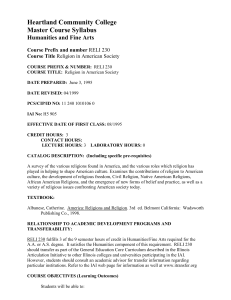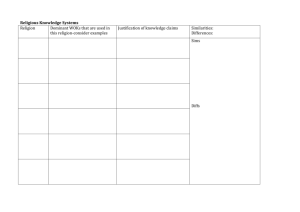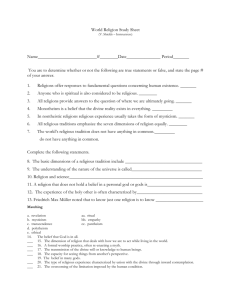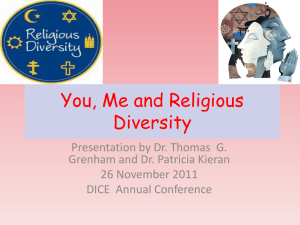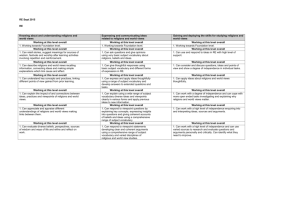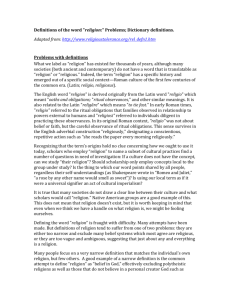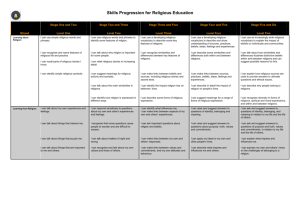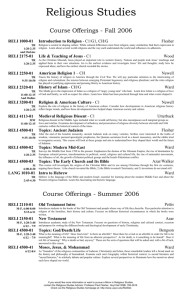RELI230_May2014 - Heartland Community College
advertisement
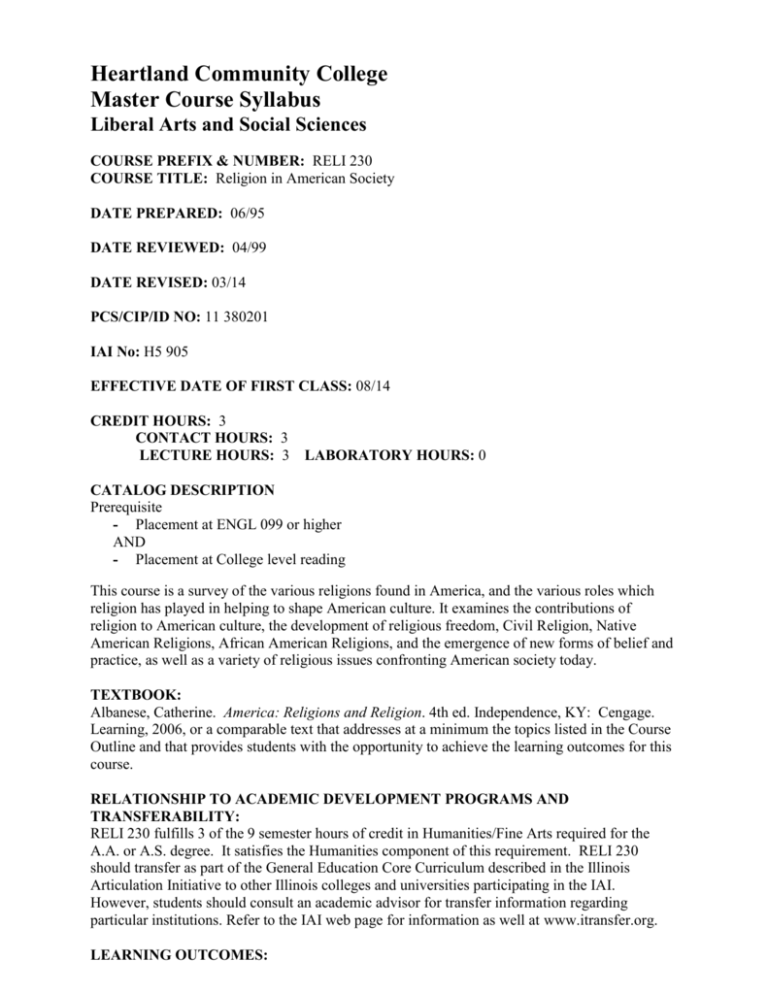
Heartland Community College Master Course Syllabus Liberal Arts and Social Sciences COURSE PREFIX & NUMBER: RELI 230 COURSE TITLE: Religion in American Society DATE PREPARED: 06/95 DATE REVIEWED: 04/99 DATE REVISED: 03/14 PCS/CIP/ID NO: 11 380201 IAI No: H5 905 EFFECTIVE DATE OF FIRST CLASS: 08/14 CREDIT HOURS: 3 CONTACT HOURS: 3 LECTURE HOURS: 3 LABORATORY HOURS: 0 CATALOG DESCRIPTION Prerequisite - Placement at ENGL 099 or higher AND - Placement at College level reading This course is a survey of the various religions found in America, and the various roles which religion has played in helping to shape American culture. It examines the contributions of religion to American culture, the development of religious freedom, Civil Religion, Native American Religions, African American Religions, and the emergence of new forms of belief and practice, as well as a variety of religious issues confronting American society today. TEXTBOOK: Albanese, Catherine. America: Religions and Religion. 4th ed. Independence, KY: Cengage. Learning, 2006, or a comparable text that addresses at a minimum the topics listed in the Course Outline and that provides students with the opportunity to achieve the learning outcomes for this course. RELATIONSHIP TO ACADEMIC DEVELOPMENT PROGRAMS AND TRANSFERABILITY: RELI 230 fulfills 3 of the 9 semester hours of credit in Humanities/Fine Arts required for the A.A. or A.S. degree. It satisfies the Humanities component of this requirement. RELI 230 should transfer as part of the General Education Core Curriculum described in the Illinois Articulation Initiative to other Illinois colleges and universities participating in the IAI. However, students should consult an academic advisor for transfer information regarding particular institutions. Refer to the IAI web page for information as well at www.itransfer.org. LEARNING OUTCOMES: After completing this course, students should be able to: 1. Demonstrate comprehension of the impact that religion has had upon American culture (CT1, DI1). 2. Articulate the major tenants of the belief and meaning systems of the religions found in America, and describe the variety of their cultural and social expressions (CT1, DI1, DI2). 3. Identify some of the major institutional organizations which have developed from or been associated with religion(s) in America (CT1). 4. Analyze how various ideas proposed by religions for the construction of American society and culture were generated by their respective belief systems, influenced by the American experience, or influenced by other ideologies (DI4). 5. Analyze critically the relationship between various social problems in America and some solutions which have their bases in religious beliefs that have been offered to address these problems. 6. Identify the nature of some of the conflicts which have arisen between religious beliefs and other cultural beliefs competing for the same cultural space and social influence (DI1, DI2). 7. Recognize the role that traditionally marginalized groups (African Americans, immigrants, women, etc.) have played in American culture in the context of religion (DI4). 8. Select, engage, and demonstrate an understanding of primary sources relevant to religion in America by composing a topical research paper (CO1, CO2). CO1: Students compose a message and provide ideas and information suitable to the topic, purpose, and audience. CO2: Students effectively deliver a message via various channels/modalities. DI1: Students are receptive to beliefs and values that differ from their own. DI2: Students consider the views of others in light of those persons’ experience and particular understandings. DI4: Students explain the contributions of diverse perspectives to the development of various fields of inquiry and to society as a whole, and re-examine their own values and beliefs in light of the insights they have gained from their study of other cultures. CT1: Students gather knowledge, apply it to a new situation, and draw reasonable conclusions in ways that demonstrate comprehension. Range of Assessment Methods: Assessment methods might include but are not limited to examinations, quizzes, papers, informal writings, oral presentations, debates, projects or group projects, and class participation. COURSE/LAB OUTLINE: I. INTRODUCTION A. The Study of Religion, and Religion in America. B. World Views, Belief Systems, Religion, and Culture. II. RELIGION IN EARLY AMERICA A. Native American Religion(s). B. The Establishment of Christianity in the Thirteen Colonies. III. RELIGION IN THE EARLY UNITED STATES A. The Rise of Religious Freedom, the Declaration of Independence, and the First Amendment to the U.S. Constitution. B. Religion and Social Reform. C. Slave Religion, and The African American Church in America. D. Religion and Community. IV. RELIGION IN THE LATER UNITED STATES A. Civil Religion. B. Religion, Culture, Society, and Politics. C. Jewish and Middle Eastern Religions in America. D. Women and Religion in America. V. NEW AND EMERGING RELIGIONS IN THE UNITED STATES A. New Age Religion. B. Neo-Paganism. METHOD OF EVALUATION (Tests/Exams, Grading System): Evaluation methods such as the following will be used to assess individual student learning. Percentage ranges will be assigned according to the instructor’s assessment preference. Discussion/participation Writing: Papers, research papers, short papers, journals Quizzes Tests Other assignments (including but not limited to: projects, interview reports, oral reports, etc.) 10 – 30% 10 – 60% 0 – 50% 30 – 70% 0 – 50% The grading scale used to determine the course grade will be: 90 to 100%= A 80 to 89%= B 70 to 79%= C 60 to 69%= D Below 60%= F REQUIRED WRITING AND READING: A minimum of 10 pages of college level writing utilizing primary and secondary sources is required in this course. Instructors may utilize a combination of various writing assignments such as research papers, projects, journals, and reports to fulfill this requirement. The number of pages to be read per week will average between 20 and 30 pages. (Estimate is based on a 16 week course schedule. Please note: if your class is not a 16 week class your weekly reading assignment will be increased.)
